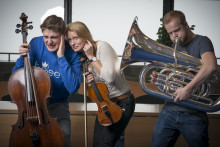 |
| Dancers crouch and stand with arms high to the sound of native instruments, simulating a pitched battle where no weapons are involved, only fist. |
Golden enstoolment of a chief
Republic of Ghana: The magnificent tribal ritual of the final ascension to power or enstoolment of a new king came alive on stage at the ITC auditorium when 11 students acted out the swearing in process of Chief NanaOpambuo II. This sub-Saharan ritual, still practiced in Africa today, covets the position as the adored royal is protected by gunmen and jewel-encrusted under a protective umbrella. One barefooted dancer, student Antony Arko-Adjei said, ‘The queen mother lobbies for the next chief to come into power, but ultimately it is the final decision of council.’
 |
| Seated comfortably in his throne on center stage, the ‘new king’ in Enschede watched as fellow Ghanaian women dance to an African beat. |
Speaking volumes with hands
Myanmar: The five petite Myanmar women, hailing from Southeast Asia, took to stage, adored with pearl necklaces and wrapped in two meters of hand-stitched fabric, known in their country as a ‘longyi’ dress. They wore silk scarves, a compulsory accessory, representing power and dignity as they offered a message of peace with delicate movements of elongated arms and hands. ‘We speak with softened fingers what is in our hearts, mostly expressing our love and hope for unity of all tribes,’ said Zizawar Win Naing, 34, a PhD in Water Management. Myanmar’s dance styles bear influences of neighboring cultures (Chinese, Indonesian and Thai).
 |
| Enjoying equal status with men, in a culture where a women’s name is her own, from birth to death: (left to right) Zizawar Win Naing, Age Thet Wai, Ei Ei Phyu, War War The, and Zar Chi Age. Photo: Gijs van Ouwerkerk |
One ballerina for one billion Chinese
China: Dancing the opening scene of one of China’s most popular ballets, Xia Li, 32, spellbound the ITC audience with her graceful pirouettes. The ‘White-haired Girl’ is regarded as a Chinese classic, and its music is familiar to almost everyone there. Li is from Xi’an, famous for its terracotta warriors and horses, funerary art buried with the First Emperor of China who died in 210 BC. Li hopes to graduate with a PhD in Geo-information Processing next spring. ‘I appreciated the chance to share my culture,’ said Li, ‘and also to have this nice memory after my six-year stay in the Netherlands.’
 |
| Li portrays the peasant girl Xi'er who waits for her father to return home so they can celebrate the Spring Festival together. Photo: Gijs van Ouwerkerk |
Celebrating heart of Africa
Rwanda: Leaping across the stage with a quiet gentleness, 18 Rwandans danced to music that beckoned us to come and celebrate life. The young men and women’s performance was particularly poignant, considering their country’s recent genocide and courageous revival into one of Africa’s richest nations. Tucked inside the women’s beaded headbands were two short sticks, showing their rank as married women and adult maidens. ‘For a moment I was transfixed,’ said Liliane Mupende Uwanziga, 30, President of the Student Association Board. She glowed while reflecting on her part in the traditional Kinyarwanda dance. ‘It felt as if I had never left home.’
 |
| Wearing the colors of their national flag, the Rwandans expressed their rich culture and hope for a new and rising future. Photo: Gijs van Ouwerkerk |
Lovers and newlyweds
Philippines: Two Filipino couples enchanted the packed audience, one with a courtship dance from Panay Island, and the other with a wedding dance from the mountainous Ifugao region. Flirting with each other, Victoria Baleta and Darwin Riguer played peek-a-boo with large handkerchiefs as they danced the Pandango sa Cariñosa. Then Lea Bron and Armand Camhol locked eyes during their Pagaddut dance which mimicked the flight of a hawk as it searches for prey, kills a white chicken, and soars triumphantly into the sky. Camhol, 27, is from the Ifugao tribe famous for the Banaue Rice Terraces built 2000 years ago which is now a UNESCO World Heritage Site. ‘When I see different cultures,’ he said, ‘it makes me proud of my own.’
 |
| Camhol learned his steps when he was five years old from older Ifugao tribesmen. Bron had three lessons from Camhol, a YouTube video, and lots of practice. Photo: Gijs van Ouwerkerk |
Wedding remembered
Nigeria: Even the audience dressed in traditional garb. Tunde Olagunju, 32, is studying Geo-environmental Engineering and appeared wearing his wedding outfit with his wife, Abimbola, 30, and their two children. For their wedding, the bride and groom of the Yoruba tribe in Western Nigeria wear Aso Oke, ceremonial clothes that include hats made of the same fabric and matching inner and outer garments. Married in 2004, Olagunju had to offer gifts to his wife’s family when he proposed, including cola nuts, bushels of yams, wine, clothes for his bride, and cash. On his wedding day, they partied late into the night. This time was different. ‘We had a lot of fun,’ he said. ‘But we had to leave early to put the kids to bed.’
 |
| Tunde and Abimbola Olagunju enjoy the evening’s entertainment while their children, Ridwanullah, 5, and Faridah, 3, nod off. |







